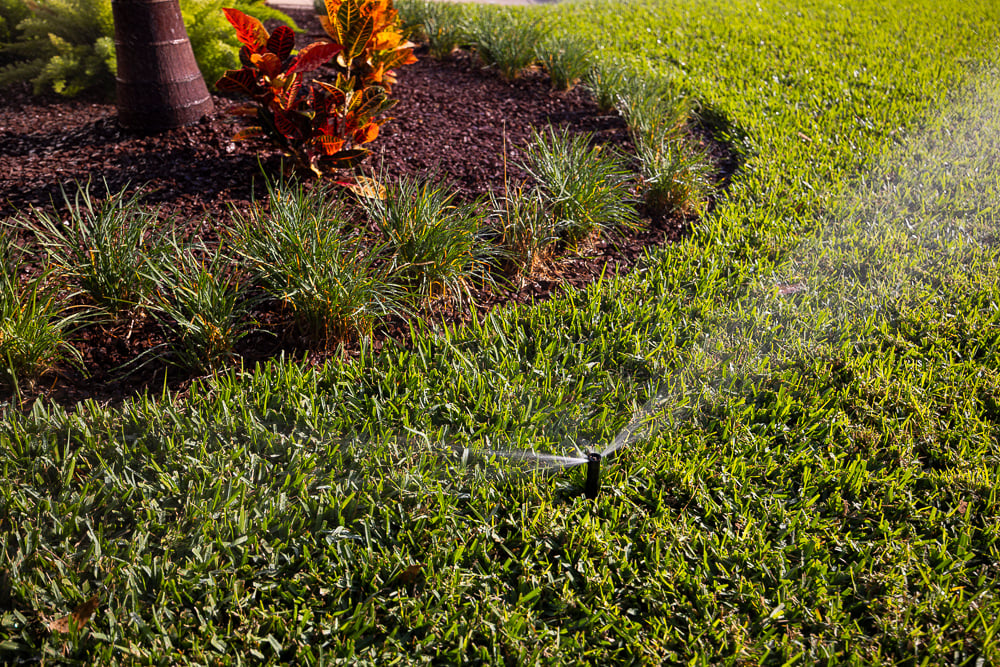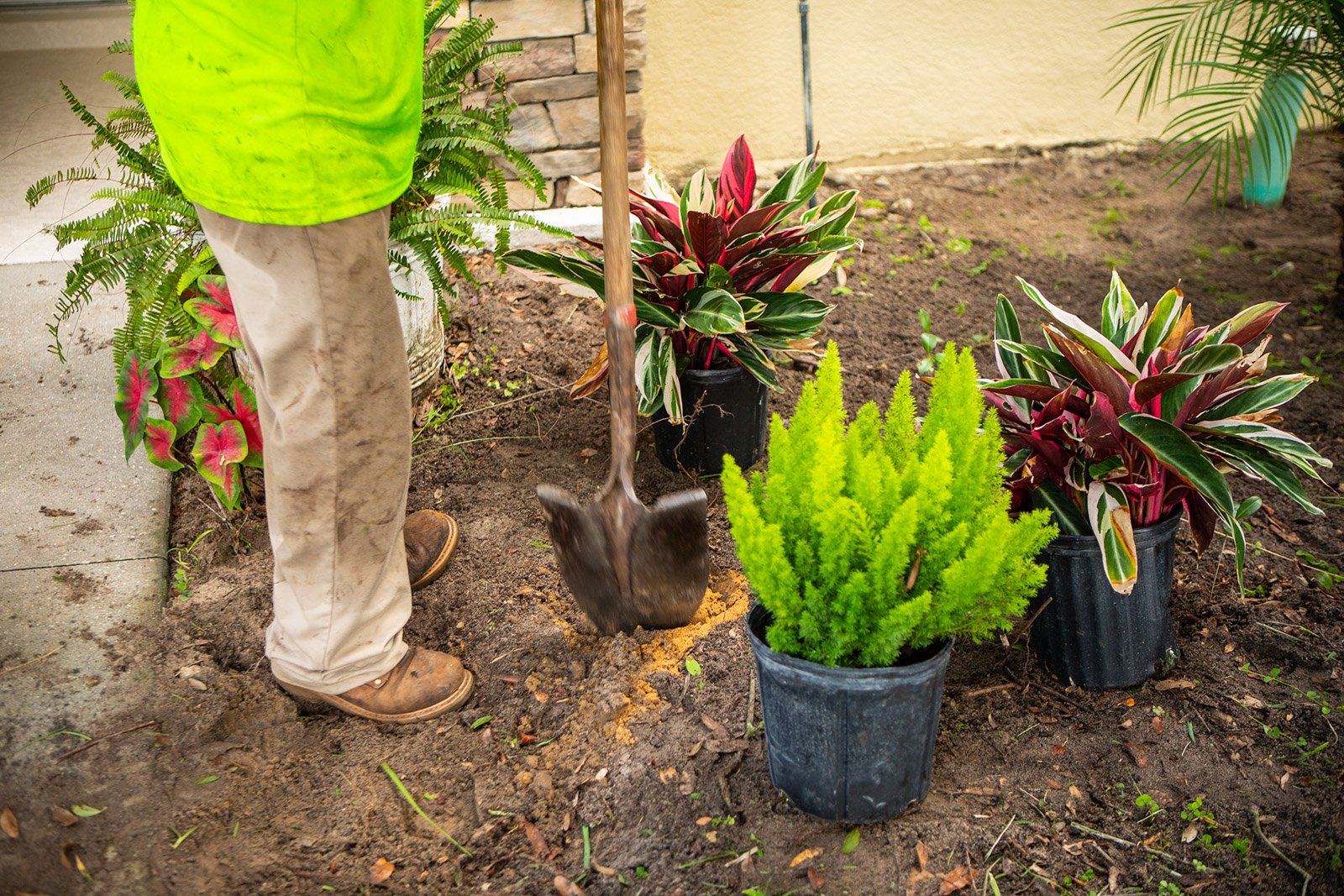Too bad we’re not answering an easier question, like “Do aliens exist?”
When it comes to irrigation for plants, Florida is tricky.
There are dry spells, and really rainy periods. The soil here is sandy, which means water easily drains right through it. Unless you live in a newer housing development where builders brought in a ton of clay to build up the area. Then your soil is thick and sticky.
Different plants here have different water needs, too.
Lots of the popular plants in Florida landscaping are tropical, like colorful crotons native to the rainforests of Malaysia. Tropical plants are often thirsty.
But if you include plants native to Florida in your landscape, like muhly grass, coontie and passion flower, they need less water once established. They’ve already adjusted to the natural climate here and often thrive in drier conditions.
Hmmm. You see the dilemma. How the heck are you supposed to attack plant irrigation here?
Let’s take a look.
Watering Tropical Plants: Give New Plants a Good Start
One trait all plants share: new plants are super thirsty. They need the most water right after you plant them, as the roots work to get established in the soil.
The goal is to give them plenty of water at first, then slowly ease up on the watering as they get settled in.

Water deeply, soaking the soil, every day for the first two weeks. The soil should be moist all the time during this period.
Water every other day for the next two to three weeks, slowly easing up on the water.
After those first few weeks of extra watering to get new plants established, you can settle into a normal watering schedule, based on what watering restrictions allow. (More on that in a minute.)
On days when it rains at least one inch, thank Mother Nature — you get the day off. A rain sensor is handy here. It communicates with your sprinkler system's controller and will stop it from watering once it’s collected approximately 3/4 inch of rain. Then it keeps it off until the device dries out.
This is all a good starting guide for plant irrigation, but pay attention to your plants. They might need more or less water. See how moist the soil is by sticking your finger into the soil near the plant.
Plants often tell you when they need more water. Watch for signs of stress like leaves that are curling, turning brown or dropping.
Hello, Microclimates
Here’s another fun thing to add to the plant irrigation mix: microclimates. They’re smaller areas of your yard that might have different conditions than the rest of the property.
A plant might be at the bottom of a slope, where extra water flows down to it. Or it might be planted near an area of concrete that soaks up and emits extra heat during the day. The exact spot a plant lives can affect its water needs.
Don’t Forget the Mulch
Mulch is your dependable partner when it comes to smart plant irrigation.
It helps your soil retain that important moisture, so you won't have to water as much. Here in hot, sunny Central Florida, that’s a real bonus.

Mulch is a multi-tasker— besides conserving water, it also keeps pesky weeds at bay by blocking the sunlight they need to sprout, and prevents rain from washing away your landscape soil.
But mulch fades in the strong Central Florida sun and breaks down over time, so you’ll need to replace it once or twice a year.
Watering Tropical Plants: Water Restrictions Play a Part
Just when you might think you have your tropical plant water needs figured out, along comes a necessary evil called watering restrictions.
More and more cities and counties are limiting the amount of water you can use for your lawn and landscaping, setting aside certain days and times that it’s allowed.
Orange County, FL watering restrictions are pretty simple: You just need to know if your house address is an even or odd number, and what month of the year it is.
Outdoor plant irrigation is limited to one day a week during Eastern Standard Time (from the first Sunday in November until the second Sunday in March) and two days a week during Daylight Saving Time (from the second Sunday in March until the first Sunday in November.)
The rules: Water only if necessary and not between 10 a.m. and 4 p.m.
Orange County FL watering restrictions also state you can’t water for longer than one hour per irrigation zone.
Happily, Orange County understands new plant irrigation needs. Orlando water restrictions allow you to water new landscaping on any day at any time for the initial 30 days after installation, and then every other day for the next 30 days.
Keep an Eye on Your Irrigation System
When every drop of water counts, make sure your sprinkler system is working in top condition.
Regular maintenance visits matter. When irrigation technicians stop over for an irrigation inspection they’ll spot the little issues that can lead to bigger problems later, from cracked lines and leaky valves to clogged nozzles or broken spray heads.

Make sure the one hour per zone that Orlando watering restrictions allow really counts.
And be sure your controller is set for the days and times Orlando water restrictions allow. You don’t want it set to turn on too many times.
Trust Your Plant Irrigation to Ground Source
Still stumped?
Not sure if your plants are thirsty tropicals or low-maintenance natives?
Can’t figure out how to set your controller to match up with Orlando watering restrictions?
Is your irrigation system acting so weird you’re not sure anything out there is getting enough water?
Take a deep breath and give us a call. Our skilled pros can help with both plant care and lawn irrigation in Central Florida.
We’re plant and irrigation experts, and we’re with you every step of the way as you plan your perfect outdoor space.
Irrigation, plant health care, landscape design: Let us transform your landscape from an embarrassing eyesore to a place you spend every spare minute.
Are you ready to enjoy the vibrant, impressive landscape you've always wanted? Request a quote today! We’ll help you review your options and then transform your property.







